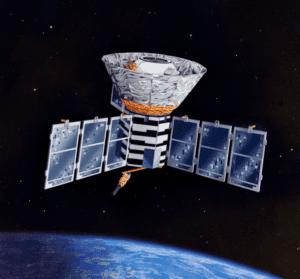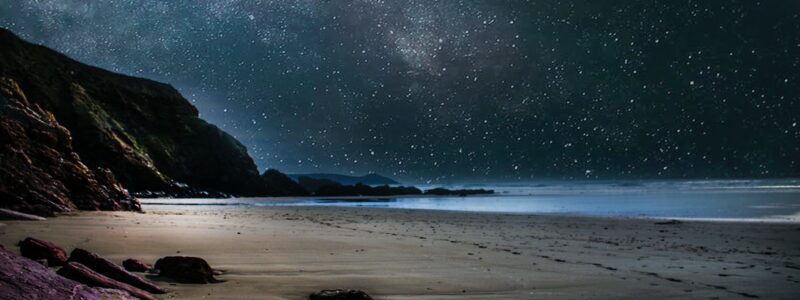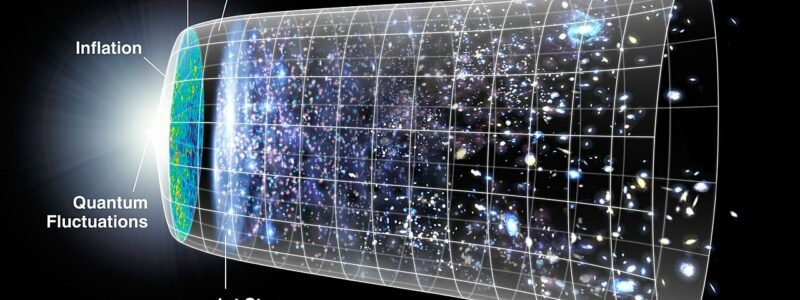COBE Finds the Big Bang
COBE Finds the Big Bang

COBE Satellite
The COBE satellite was able to find hard evidence for the occurrence of the Big Bang. Further study would make this event one of the best understood and best-documented events in the history of the universe.
One of the greatest discoveries of the twentieth century was the cosmic background radiation and what it means. The background radiation comes to earth from all directions equally and is nearly exactly the same (isotopy) in all directions as well. The existence and characteristics of this radiation were predicted decades before its initial characterization in 1992, but the importance of its actual discovery and characterization can hardly be overstated.
On April 24, 1992, newspapers around the world excitedly proclaimed a breakthrough by an American research team. Many newspapers continued to educate the public on its importance for many days afterward. American TV networks reported on very little else during the day of its discovery.
COBE Finds the Big Bang – Why this is Important
The importance was that results from the COBE satellite gave a front-row seat view of the creation of the Universe; it showed the Universe in its infancy and gave a glimpse into how galaxies were first forms.
But the biggest importance was that it proved the basic narrative of the Big Bang theory; namely, that the Universe and all that is including mass, energy, space, and even time itself all had a beginning in a point of time.
The Universe was not eternal as had been supposed in the early part of the twentieth century. The theory implies there was nothing – absolutely nothing – prior to this event; it was literally created ex nihilo just as Scripture says in Genesis 1.
Reactions
The importance of any scientific discovery can be better understood by reading the excited reactions of scientists associated with the discovery. Carlos Frenk of Britain’s Durham University noted
[It’s] the most exciting thing that’s happened in my life as a cosmologist.
Theoretical physicist Stephen Hawking said,
It is the discovery of the century, if not of all time.
Michael Turner an astrophysicist from the University of Chicago, noted the discovery was “unbelievably important” and that its importance “cannot be overstated. They have found the Holy Grail of cosmology.”
Theistic pronouncements also abounded – in addition to those from the scientific community. For example, science historian Frederic B. Burnham noted the idea that God created the universe
a more respectable hypothesis today than at any time in the last hundred years.
The Big Bang
Astronomers had long posited the Universe was extremely ancient – and most felt that it had no beginning. The infinite size and age of the Universe meant there did not need to be a creator since the universe was never created.
The Big Bang hypothesis countered by saying that not only did the universe have a beginning, but it was also only about 13.8 billion years old. This was considered to be far too young to allow for the vast amounts of time needed to spontaneously create all that exists. The Big Bang posits that the entire physical universe – everything material there is that exists, all the matter, space, time, and energy we have been experiencing since the “beginning” all derived from a state of near-infinite temperature, density, and pressure.
The volume of the initial universe is thought to be infinitesimally smaller than the period at the end of this sentence; it has subsequently expanded to a radius of at least 13.8 billion light years.
Scientists posited a great deal about the existing universe prior to April 1992. Richard Tolman noted in 1922 for the universe to be expanding, it must be cooling off from an initial very high-temperature state. George Gamow noted that only a universe characterized by initial very high temperatures could explain how protons and neutrons fused together producing a universe that was 74% hydrogen, 24% helium, and 2% lighter elements.
The COBE satellite was produced specifically to find how the galaxies formed from a Big Bang creation event.
Prediction of the Big Bang
Scientists knew if they could determine the volume and temperature of the initial universe, they should be able to determine the current temperature of space. But the expansion of the universe has to be precisely determined. If the universe spent too much time when the nuclear fusion of elements occurred, then there would be too much of the heavier elements and too little of the elements required for life.
On the other hand, if the expansion were too rapid, then the universe would spend too little time in the nuclear fusion temperature and too few life elements would be produced. George Gamow calculated in 1948 the temperature of the current universe from the initial conditions necessary to yield the currently observed abundances of elements. They believed that a very low temperature of about 5 degrees centigrade above absolute zero should be found everywhere throughout the universe.
Arno Penzias and Robert Wilson put together an instrument in 1948 which successfully was able to measure this background radiation and got a temperature of about 3 degrees centigrade above absolute zero. Since that initial discovery, the cosmic background radiation has been measured at ever-increasing accuracy.
Only a telescope operating in space could make the evaluation since most of the radiation produced in space at this temperature is absorbed by Earth’s atmosphere.
COBE (Cosmic Background Explorer) Satellite Finds the Big Bang
Cosmologists have determined that the universe must have had an extremely hot beginning about 14 billion years ago. When the universe was about 10^-34 of a second old it experienced tremendous expansion known as inflation during which time-space expanded faster than the speed of light. It went from a subatomic sized to golf ball sized almost instantaneously. The first three minutes of the Universe’s existence produced the light elements in a process known as Big Bang nucleosynthesis. Temperatures went from about 10^32 Centigrade to about 1 billion degrees. During this time, protons and neutrons collided to make deuterium – an isotope of hydrogen. Most of the deuterium then went on to create helium and trace amounts of lithium.
A large flash of light was created during the Big Bang event but could not escape the dense plasma of the initial creation event. After about 380,000 years after the Big Bang, the Universe had cooled enough for electrons to be captured by nuclei allowing stable atoms to form. The universe then became transparent as photons of light could escape forming the background radiation we see today.

CBR spectrum
Initial results from the COBE satellite showed the background radiation is like a perfect “black body” radiator; this would be predicted from the Big Bang model noted above. George Gamow calculated what temperature conditions would be needed to produce the relative amounts of hydrogen and helium we see today. He concluded that there should be a faint glow of radiation at about 5 degrees above absolute zero (5 degrees Kelvin) everywhere throughout the universe. The COBE satellite was able to determine the actual temperature to be just less than 3 degrees Kelvin.
The background radiation was shown to be extremely uniform in all directions with only very minimal irregularities. These irregularities were about 1 part in 100,000 and solved a mystery. It is thought that these minimal irregularities are associated with the formation of large structures in the Universe such as galaxies.
Confirmation by the Keck Telescope
The background radiation provides a temperature of 2.726 degrees Kelvin is the temperature of the universe in our current time. The temperature of the Universe has been cooling as the Universe gets larger; therefore, it should be hotter in the distant past.
The Keck telescope tried to measure the actual past temperature of the universe by measuring the radiation from great distances. If the hot Big Bang model is correct, then the temperature of the background radiation at large distances should be greater than it is today. In September 1994, the Keck telescope was used to measure the spectral lines of carbon in two gas clouds so distant that their radiation represents an era when the universe was about one-fourth of its current age. The predicted temperature was 7.58 K and the actual temperature calculated for the Keck telescope measurements was 7.4 +- 0.8 K.
In 2000, another team evaluated the universe temperature at a distance where the universe is one-sixth its present age. They detected background radiation at a temperature of about 10 degrees K again matching that predicted by the hot big bang model.
Confirmation by Visual Observation
The Big Bang was confirmed by measuring the temperature of the background cosmic radiation in distant gas clouds is one thing, but seeing actual visual evidence is another. Until recently, imaging the very distant universe with ground telescopes was difficult due to the size of the telescope required and the intervening earth atmosphere interfering with the quality of images obtained.
These problems have been resolved with the newer breed of the newest generation of ground-based telescopes such as the Keck Observatory in Hawaii and the Hubble Space Telescope. These telescopes can produce images of stars and gas first merging to form galaxies about 13 billion years ago up to the present. The images show how elliptical and spiral galaxies grow in size and structure as the universe ages.
Images of galaxies that are extremely far away allow the observer to actually look back in time. We can actually see the early formation of stars and galaxies where they do not have the mature structure galaxies have today. It takes countless millions of years for forces of gravity and physics to form the structure say of a spiral galaxy like our own.
These observations produce visual confirmation of the birth of our Universe.
References
Ross, Hugh. The Creator and the Cosmos: How the Latest Scientific Discoveries Reveal God (Kindle Location 4668). RTB Press. Kindle Edition.




